Hispanic Dump-Truck Driver Dies After Being Caught Between Frame and Dump Body of Off-Road Truck While Performing Routine Lubrication - Tennessee
NIOSH In-house FACE Report 2002-08
Summary
On June 24, 2002, a 21-year-old Hispanic dump-truck driver (the victim) died after being caught between the frame and dump body of an off-road dump truck while performing routine lubrication. The victim was working for an excavation contractor at a landfill expansion site on the day of the incident. The victim’s foreman drove by the area where the company service truck was set up and stopped to investigate when he heard the air compressor running but not the usual clicking sounds made when workers are greasing their trucks. He found the victim caught between the frame and dump body of the truck. The foreman called out for help and then called 911 from his cell phone. An excavator operator working nearby responded to the foreman’s call for help and climbed into the cab of the truck and raised the bed. Emergency medical services (EMS) and law enforcement personnel responded within 10 minutes. EMS personnel transported the victim by ambulance to a local hospital where he was pronounced dead.
NIOSH investigators concluded that, to help prevent similar occurrences, employers should:
- ensure that raised dump bodies are blocked against inadvertent lowering before employees work under them
- develop, implement, and enforce a comprehensive written safety program for all workers which includes training in the recognition and avoidance of unsafe conditions and in required safe work practices that apply to their work environments
- ensure that workers who are part of a multilingual workforce comprehend instructions in safe work procedures for the tasks to which they are assigned
Introduction
On June 24, 2002, a 21-year-old Hispanic dump-truck driver (the victim) died after being caught between the frame and dump body of an off-road dump truck while he was performing routine lubrication. On June 25, 2002, officials of the Tennessee Occupational Safety and Health Administration (TOSHA) notified the National Institute for Occupational Safety and Health (NIOSH), Division of Safety Research (DSR), of the incident. On July 9, 2002, a DSR safety and occupational health specialist met with one of two TOSHA compliance officers who had investigated the incident to discuss the case and to review information collected and photographs taken during the course of the TOSHA investigation. The second TOSHA compliance officer was interviewed by telephone at a later date. The DSR safety and health specialist also met with the company’s site superintendent, took photographs of the truck involved in the incident, and observed the company mechanic operate the truck dump body hoist. The sheriff’s report was reviewed. An inspection report completed by an authorized representative of the truck manufacturer was reviewed and an operator’s manual was obtained. The official cause of death was obtained from the death certificate. The victim’s foreman was interviewed by telephone several weeks after the DSR site visit.
The victim’s employer was an excavation contractor that had been in business for 15 years. The company had several excavation jobs in progress throughout the region and employed approximately 70 to 80 employees during the summer months. The incident occurred at a sanitary landfill where the company had been working over a 5-month period to construct a 15-acre expansion to the landfill. The work shift lasted approximately 12 hours starting at 6 a.m. and ending at 6 p.m.
The victim had moved from Mexico to the United States to work for the excavation company 3 months before the incident. At the time of the incident, approximately 20 of the company’s employees, including the victim, were Mexican nationals whose primary language was Spanish. Twelve employees were working at the landfill site on the day of the incident, including the victim, four other off-road dump-truck drivers, two excavator operators, three bulldozer operators, one grader operator, and a foreman. The primary language of the off-road drivers at the incident site was Spanish.
The company had no written safety policies. According to the site superintendent, safety responsibilities were shared by the site foreman, the site superintendent, and the company owner. According to the company’s site superintendent, off-road dump truck-drivers were given 1 to 5 days of on-the-job training by an experienced driver. After the new employee received the training, the foreman observed the trainee and, if satisfied with the trainee’s driving skills, assigned the new driver to an off-road dump truck. When he was hired, the victim had no previous experience operating off-road dump trucks. He did not possess a valid driver’s license nor was one required by any U.S. regulatory agencies or by the employer for this type of off-road vehicle. The content and length of the victim’s training was not documented. The site foreman, the superintendent, and the company owner were not bilingual. Several of the company employees were bilingual and were assigned to help convey information to Spanish-speaking employees. The victim’s driver training had been provided by an experienced driver who spoke Spanish. The victim’s foreman reported that he felt the victim understood some English but spoke very little English. This was the company’s first workplace fatality.
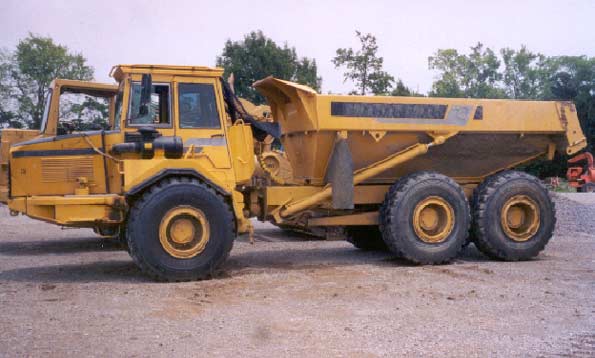
Photo 1. This photo illustrates the machine that was being serviced at the time of the incident.
Back to Top
Investigation
The site of the incident was a landfill where a new cell for refuse disposal was being constructed by an excavation company. To create the new cell, the excavation company was to remove and haul soil from a 15-acre area and then place a layer of sand and gravel into the excavation. After another company placed a liner on top of the sand and gravel, the excavation company was to place a layer of pea gravel 12 inches deep over the liner to complete the cell. The excavation company had worked at the site for 5 months before the incident and planned to complete the job in another 5 months. Five drivers, including the victim, were assigned to operate off-road trucks (Photo 1) and spent the day of the incident hauling earth from the excavation site to another area of the landfill. An excavator operator was loading the dump trucks and a bulldozer was working nearby.
Near the end of the shift, at approximately 6:30 p.m., three dump-truck operators drove to the service area (Photo 2) to grease their trucks as the excavator operator was not yet ready to load their trucks. The service truck contained an air compressor and a pneumatic grease gun. Lubricating trucks using an air-operated grease gun was a duty routinely performed by dump-truck operators once each shift or once every other day, whenever there was a slow period. According to the sheriff’s report, the victim and the other two drivers drove to the service area. After the victim’s coworkers finished lubricating their trucks, they drove their trucks out of the service area. They told police the victim was alone at the service station and was getting into his assigned truck as they drove away.
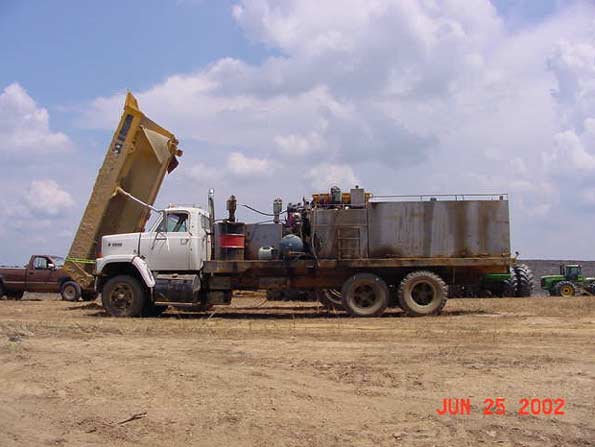
Photo 2. This photograph illustrates the placement of the service truck and dump truck that the victim was servicing at the time of the incident. Photograph courtesy of TOSHA.
The foreman had been working with another crew engaged in building a temporary haul road, and when he finished at approximately 7 p.m., he drove by the service area. He stopped his truck and went to investigate when he saw a truck in the service area with its engine running and heard the air compressor running but did not hear the usual clicking sounds of the grease gun. He found the victim caught face down between the truck frame and dump body near a grease fitting located toward the cab end of the frame (Photo 3). The foreman reported that the dump body lock, a bar that holds the raised dump body in place and is manually secured with a rod and cotter pin, was not in place. The foreman called out for help and then called 911 from his cell phone. An excavator operator responded to the foreman’s call for help, climbed into the cab of the truck, raised the dump body, and secured it in the hold position. He then went to the back of the truck and secured the dump body safety lock (Figure 1 and Photo 4) located at the rear of the truck. Approximately 10 minutes after receiving the 911 call, emergency medical services (EMS) and law enforcement personnel responded. EMS personnel transported the victim by ambulance to a local hospital where he was pronounced dead.
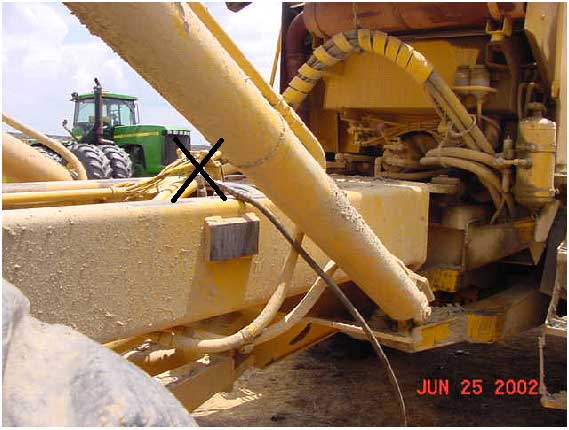
Photo 3. This photo illustrates the area of the truck where the victim was working at the time of the incident. Note the grease gun’s rubber hose. The X demonstrates the approximate location of the victim following the incident. Photograph courtesy of TOSHA.
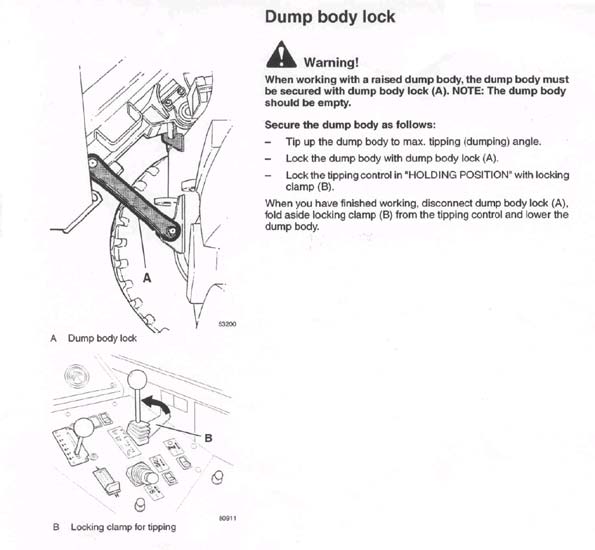
Figure 1. This figure illustrates the correct procedure for securing the dump body lock. The figure is used with the permission of the equipment dealer and is located on page 118 of the operator’s manual. 1
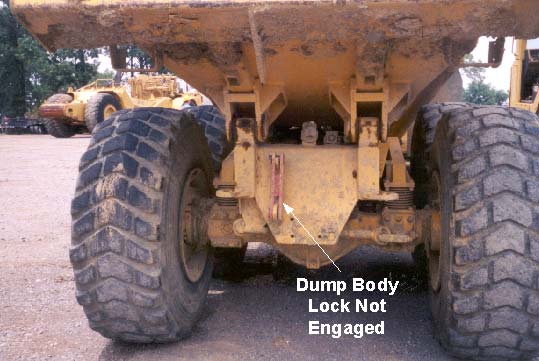
Photo 4. This photograph was taken from the rear of the truck. The arrow points to the dump body lock and illustrates the position of the dump body lock when the dump body is in the lowered position and the dump body lock is not engaged.
The 49,000-pound gross vehicle weight (GVW), 6-wheeled, off-road dump truck involved in the incident was manufactured in 1996. It had been purchased used at an auction several years before the incident. The company had its own maintenance department which was responsible for its fleet of 30 trucks. According to the company mechanic, routine lubrication on trucks was performed by the assigned drivers, not by maintenance, and normally included servicing 16 grease fittings. Employees normally began lubrication at the rear and finished at the grease fitting located nearest the front end of the frame. The mechanic raised the dump body and demonstrated to the DSR investigator how the dump body was manually secured with the dump body lock. Operating instructions provided by the manufacturer indicate that before employees perform any type of work under a raised dump body, the tipping control used to raise the dump body should be placed in the hold position (position #3) and locked with the locking clamp. The dump body lock at the rear of the truck is then manually secured (Photo 5).
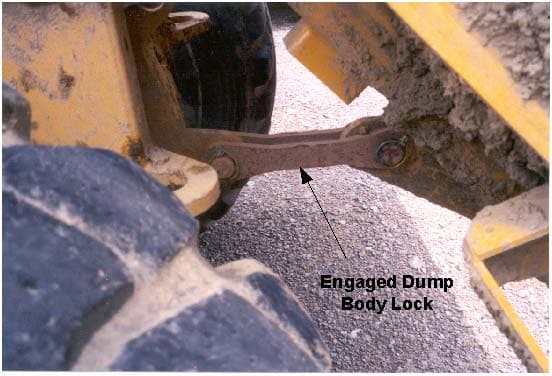
Photo 5. This photograph was taken from the rear of the truck and illustrates the dump body lock (highlighted with an arrow) when the dump body is in the raised position and the dump body lock has been engaged.
The truck was inspected by a manufacturer’s representative 4 days after the incident. The inspection focused on the function of the bed hoist circuit and the safety equipment. The DSR investigator discussed the inspection findings with the inspector and was told that the bed hoist circuit was functioning satisfactorily. The inspector also evaluated the function of the safety equipment for the bed function and found that “the rear bed safety lock and the hoist lever hold lock (locking clamp) were both functional.”
Evidence suggests that the victim had raised the dump body, exited the truck with the engine running, and entered the space between the dump body and frame to lubricate the suspension system and drive shaft without first placing the tipping control lever in the hold position #3 and securing the locking clamp, and without manually securing the dump body lock at the rear of the truck. The incident was unwitnessed and, therefore, no absolute explanation of what caused the dump body to lower is available. It is clear, however, that the dump body lock was not secured, therefore, there was nothing to keep the dump body in the raised position should the tipping control lever become dislodged for any reason. As indicated earlier, tests conducted by the manufacturer demonstrated that the hoist circuit had no malfunctions, leakage of hydraulic fluids was not evident, and the hydraulic pressure was within normal limits at 2650 psi.
Back to Top
Cause of Death
The death certificate indicated that the cause of death was a crush injury to the neck.
Recommendations and Discussion
Recommendation #1: Employers should ensure that raised dump bodies are blocked against inadvertent lowering before employees work under them.
Discussion: According to the site superintendent, the victim had been provided with on-the-job training in safe operation of the off-road dump truck. The victim’s foreman reported that the victim had been shown the procedure for manually securing the dump body lock and that he had seen him engage the dump body lock on previous occasions. Several of the victim’s coworkers told the TOSHA investigator that working under a dump body without first securing the dump body lock was not an acceptable practice to them or to their employer. However, no documentation existed that indicated that the victim or his coworkers had received safety training in accordance with the manufacturer’s safety recommendations for working under raised dump bodies. The victim’s foreman informed the DSR investigator that the operator’s manual for the truck involved in the incident was kept in the cab. The operator’s manual is in English and contained safety warnings for workers performing basic preventive maintenance with the dump body raised (Figure 1 ).
Employers should always identify an effective method to convey to workers that failure to comply with these safety procedures could result in injury or death. Periodic inspections should be conducted by supervisors to ensure worker compliance with these safety measures. Coaching, retraining and progressive disciplinary measures should be instituted to ensure compliance with these safety measures.
Recommendation #2: Employers should develop, implement, and enforce a comprehensive written safety program for all workers which includes training in the recognition and avoidance of unsafe conditions and in required safe work practices that apply to their work environments.
Discussion: Employers should evaluate tasks performed by workers, identify all potential hazards, then develop, implement and enforce a written safety program addressing these hazards. Additionally, according to 29 CFR 1926.21 (b)(2)2, “the employer shall instruct each employee in the recognition and avoidance of unsafe conditions and the regulations applicable to their work environment to control or eliminate any hazards or other exposure to injury or illness.” In this incident, the victim may have failed to recognize the hazards present when he raised the dump body and entered the space between the raised dump body and the frame of the off-road dump truck without first securing the dump body lock and the tipping control lever with the locking clamp. Training in hazard recognition, control, and avoidance may have helped the victim recognize the hazard and the need to use all of the safety devices provided. Safety training should be reinforced by holding periodic safety meetings where safety issues are discussed and hazard controls reviewed. The content of the safety training provided and the names of employees that attended the training/safety meeting should be documented and kept for future reference.
Recommendation #3: Employers should ensure that workers who are part of a multilingual workforce comprehend instructions in safe work procedures for the tasks to which they are assigned.
Discussion: Companies that employ workers who do not understand English should identify the languages spoken by their employees, and design, implement, and enforce a multi-language safety program. To the extent feasible, the safety program should be developed at a literacy level that corresponds with the literacy level of the company’s workforce. Companies may need to consider providing special safety training for workers with low literacy to meet their safety responsibilities. The program, in addition to being multi-language, should include a competent interpreter to explain worker rights to protection in the workplace, safe work practices workers are expected to adhere to, specific safety protection for all tasks performed, ways to identify and avoid hazards, and who they should contact when safety and health issues arise. Employers should also develop safety posters and signs in the appropriate languages and post them in conspicuous places.
Back to Top
References
- Operator’s Manual for Volvo A25C. Volvo Construction Equipment Group. Ref. no. 21 1 431 3063.
- Code of Federal Regulations 2001 edition. 29 CFR 1926.21 (b)(2). Safety Training and Education. U.S. Printing Office, Office of the Federal Register, Washington, D.C.
Investigator Information
This investigation was conducted by Doloris N. Higgins, Safety and Occupational Health Specialist, Fatality Assessment and Control Evaluation Team, Surveillance and Field Investigations Branch, Division of Safety Research.
